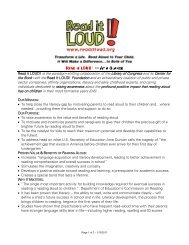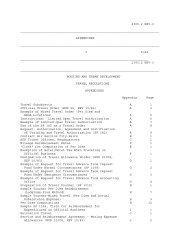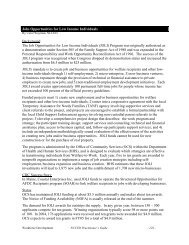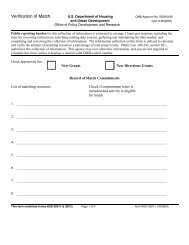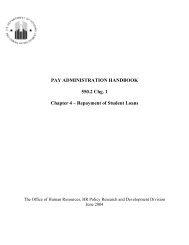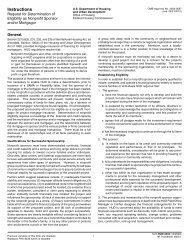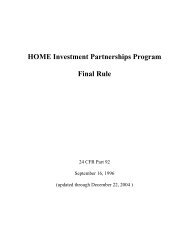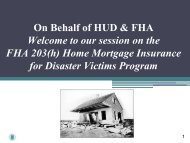Housing Choice Voucher Newsletter - July 2011, Volume 2 ... - HUD
Housing Choice Voucher Newsletter - July 2011, Volume 2 ... - HUD
Housing Choice Voucher Newsletter - July 2011, Volume 2 ... - HUD
- No tags were found...
You also want an ePaper? Increase the reach of your titles
YUMPU automatically turns print PDFs into web optimized ePapers that Google loves.
<strong>Housing</strong> <strong>Choice</strong> <strong>Voucher</strong> E-<strong>Newsletter</strong><br />
<strong>July</strong> <strong>2011</strong> | <strong>Volume</strong> 2, Issue 7<br />
http://www.hud.gov/offices/pih/programs/hcv/<br />
IN THIS ISSUE<br />
» <strong>HUD</strong> Funding Provisions for<br />
the <strong>Housing</strong> <strong>Choice</strong> <strong>Voucher</strong><br />
Program Issued<br />
» PIH Notices<br />
» The Disaster <strong>Housing</strong><br />
Assistance Program (DHAP)<br />
<strong>HUD</strong> Funding Provisions for the <strong>Housing</strong> <strong>Choice</strong><br />
<strong>Voucher</strong> Program Issued<br />
<strong>HUD</strong> recently issued Notice PIH <strong>2011</strong>-27 (HA) “Implementation of the Federal Fiscal<br />
Year <strong>2011</strong> Funding Provisions for the <strong>Housing</strong> <strong>Choice</strong> <strong>Voucher</strong> (HCV) Program.”<br />
This Notice provides the allocation procedure for determining housing assistance<br />
payments (HAP) renewal funds, new incremental vouchers, and administrative fees as<br />
provided in the Appropriations Act for <strong>2011</strong>, referred to in the Notice as “the <strong>2011</strong><br />
Act.” Detailed information is provided in the Notice regarding how <strong>HUD</strong> calculates<br />
funding for each HCV program administered by public housing agencies (PHAs). PHAs<br />
will also receive a funding letter with individual funding calculations.<br />
The Notice is divided into sections outlining the funding for vouchers and administrative<br />
fees, and other policy issues.<br />
The Notice provides an explanation of funding for tenant protection vouchers such<br />
as those for tenants facing housing conversion actions, and funding for administrative<br />
costs including ongoing administrative fees and new voucher administrative fees.<br />
Other funding topics discussed in the Notice include use of HAP net restricted assets<br />
(NRA), Family Self-Sufficiency (FSS), Veterans Affairs Supportive <strong>Housing</strong> (VASH),<br />
and HAP disbursements and adjustments to monthly disbursements. Funding for the<br />
Mainstream 5 program (MS5) according to the <strong>2011</strong> Act will come from the Tenant-<br />
Based Rental Assistance Account (TBRA) for the renewal funding for the remainder<br />
of CY <strong>2011</strong>.<br />
Additionally, <strong>HUD</strong> reminds PHAs in this Notice that PHAs must manage their programs<br />
“in a prudent manner to enable them to serve families within their CY<strong>2011</strong><br />
allocations and voucher baselines.” <strong>HUD</strong> plans to continue to monitor utilization and<br />
to conduct on-site reviews of PHAs to ensure data integrity. The Notice indicates<br />
that Moving to Work (MTW) agencies continue to have funding based on their MTW<br />
agreements.<br />
PHAs with questions regarding funding allocations should contact the <strong>Housing</strong> <strong>Voucher</strong><br />
Financial Management Division, Office of Public <strong>Housing</strong> and <strong>Voucher</strong> Programs, at<br />
202-708-2934.<br />
To view the Notice go to: http://1.usa.gov/iW69DI<br />
PIH Notices<br />
PIH <strong>2011</strong>-29, “HQS Inspections for the <strong>Housing</strong> <strong>Choice</strong> <strong>Voucher</strong> Program and Guidance<br />
Related to Electrical Outlets,” issued June 3, <strong>2011</strong>. This Notice reviews the<br />
existing <strong>Housing</strong> Quality Standards (HQS) requirements and clarifies the existing guidance<br />
that PHAs may rely upon when conducting inspections. It also offers additional<br />
guidance on what types of three-prong electrical outlets an inspector should consider<br />
acceptable under HQS.<br />
Cont’d<br />
E-<strong>Newsletter</strong> of the <strong>HUD</strong> <strong>Housing</strong> <strong>Choice</strong> <strong>Voucher</strong> Program
PIH <strong>2011</strong>-28, “Cost- Savings Measures in the <strong>Housing</strong> <strong>Choice</strong> <strong>Voucher</strong> (HCV) Program,” issued May 27, <strong>2011</strong>. This Notice extends<br />
and revises Notice PIH 2009-44 which provided: (1) guidance on actions PHAs may take to address financial shortfalls by<br />
reducing costs in the HCV program; and (2) information on the circumstances under which a PHA may deny a move under 24 CFR<br />
982.314(e)(1) or terminate a HAP contract under 24 CFR 982.454 as a result of insufficient funding.<br />
PIH <strong>2011</strong>-27, “Implementation of the Federal Fiscal Year <strong>2011</strong> Funding Provisions for the <strong>Housing</strong> <strong>Choice</strong> <strong>Voucher</strong> Program,” issued<br />
June 2, <strong>2011</strong>. This Notice implements the HCV program funding provisions of H.R. 1473 Department of Defense and Full-Year<br />
Continuing Appropriations Act, <strong>2011</strong> (PL 112-10). This Notice is discussed more fully in this newsletter.<br />
PIH <strong>2011</strong>-25, “Extension: Administrative Guidance for Effective and Mandated Use of the Enterprise Income Verification (EIV)<br />
System,” issued May 30, <strong>2011</strong>. This Notice extends Notice PIH-2010-19(HA), same subject, for another year until May 31, 2012.<br />
To view the Notices: http://www.hud.gov/offices/pih/publications/notices/<br />
The Disaster <strong>Housing</strong> Assistance Program (DHAP)<br />
The Disaster <strong>Housing</strong> Assistance Program (DHAP) is a pilot program that was created by the Federal Emergency Management<br />
Agency (FEMA) and <strong>HUD</strong> in the wake of Hurricanes Katrina and Rita, and implemented a second time after Hurricanes Ike and<br />
Gustav. DHAP is an effective temporary rental housing assistance program designed to help families rebuild their lives as they move<br />
toward greater self-sufficiency. To reach families nationwide, <strong>HUD</strong> used its extensive network of PHAs to provide the housing assistance<br />
and case management services to eligible families. Along with providing case management services, a critical component of the<br />
program is the implementation of an incremental rent transition (IRT). Families are required to pay a portion of their rent in preparation<br />
towards self-sufficiency when DHAP ends. PHAs implement the IRT by reducing the rental subsidy payment by an additional<br />
$50 each month until the family’s participation in DHAP ends, the rent subsidy amount equals $0, or the program concludes, whichever<br />
comes first. Should the IRT place too much of a financial strain on a family, the PHA has the ability to grant a hardship waiver<br />
which would freeze the family’s portion owed at an increment they can afford.<br />
Through DHAP-Katrina, almost 37,000 families received rental housing assistance and case management services. At the conclusion<br />
of the program, approximately 22,000 of the program’s participants had reached self-sufficiency and were able to pay the full<br />
amount of their rental housing costs. More than 14,000 families were placed in a permanent housing solution, most of which were<br />
the elderly and disabled.<br />
The epic success of DHAP-Katrina prompted the call for DHAP-Ike after Hurricanes Ike and Gustav left thousands of families<br />
displaced from their homes. DHAP-Ike began on November 1, 2008, and was originally scheduled to end in March 2010. However, in<br />
response to the ongoing needs of DHAP-Ike families, the program was ultimately extended to September 30, <strong>2011</strong>. To date DHAP-<br />
Ike has assisted almost 27,000 families in need of housing assistance. Currently there are 4,344 families remaining on the program,<br />
of which, approximately 98 percent require a hardship waiver due to financial burden.<br />
As the end of DHAP-Ike approaches, <strong>HUD</strong> continues its efforts to meet the housing and community needs of those displaced, without<br />
forcing families into inadequate choices. <strong>HUD</strong> and PHA staff persist in giving those families a better range of options so that they<br />
may transition seamlessly from DHAP-Ike to a viable alternative housing solution.<br />
To learn more, visit http://1.usa.gov/mOKxgS<br />
Contact us:<br />
Toll free number: 1-800-955-2232<br />
Public and Indian <strong>Housing</strong> Information<br />
Resource Center (PIH IRC)<br />
2614 Chapel Lake Drive<br />
Gambrills, MD 21054<br />
Fax number: 1-443-302-2084<br />
E-mail: pihirc@firstpic.org<br />
(Put “<strong>Housing</strong> <strong>Choice</strong> <strong>Voucher</strong><br />
E-<strong>Newsletter</strong>” in the subject line)<br />
E-<strong>Newsletter</strong> of the <strong>HUD</strong> <strong>Housing</strong> <strong>Choice</strong> <strong>Voucher</strong> Program



